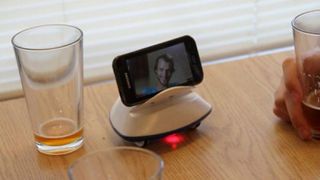Telepresence: Rise of the telerobots
Teleportation may not exist yet, but perhaps telepresence will do for now
iRobot also has a diverse line in defence robots for the military, including machines to accompany infantry troops into battle, bomb disposal and HazMat robots, plus emergency units for first responders.
Around the house
Due to their cost and sophistication, high-end telepresence systems like those above are likely to remain the purview of business or government in the near future, but the same concept can be applied to consumer products.
Indeed, the growth of the app-enabled smartphone has given rise to a large number of crowdfunded telepresence concepts that turn your Android or iPhone into a fully mobile, remote control bot.
If you're in the market for your own telepresence robot and don't mind pledging at least $100, check out successful Kickstarter projects like Botiful and Romo.

Out and about
Aside from these kinds of simpler devices aimed at the home market, there's huge scope for industrial telepresence concepts to be used for consumer purposes, in all sorts of areas where it can be difficult for people to get to places.
The CSIRO, in conjunction with the Department of Broadband, Communications and Digital Economy, is developing a telepresence robot for the National Museum of Australia, aimed at enabling remote users (like students in rural areas and the elderly) to virtually visit the museum through the eyes and ears of a mobile robot.
The robot will be able to accompany a human teacher or guide on a live tour of the museum, self-navigating through any wheelchair-accessible space.
Get daily insight, inspiration and deals in your inbox
Get the hottest deals available in your inbox plus news, reviews, opinion, analysis and more from the TechRadar team.
A 360° panoramic camera will enable remote students and visitors to control their own independent, interactive view of the tour from the robot's vantage point in real time, while accessing additional museum data from its computers and communicating with other virtual participants.
Social telepresence
To keep in touch with distant friends and family, most people tend to be satisfied with Facebook and Skype.
However, if you're really, really missing that special someone, the fledgling field of social telepresence robots may be able to help.
Researchers from Japan's Yamagata University have developed the MH-2, a miniature wearable telepresence robot that sits astride your shoulder and basically hangs out with you as you go about your day.
With two mini cameras on either side of the avatar's head, your remote friend gets to see everything you're up to, and a huge rig of tiny servos enables a robotic recreation of their movements, from head, hand and arm gestures down to breathing movements being replicated.
It's a work in progress and requires a huge shoulder pack to power the motions.
The MH-2 might be a bit of an ugly duckling right now, but it's an intriguing proof of concept for potential consumer products in the future.

Most Popular

